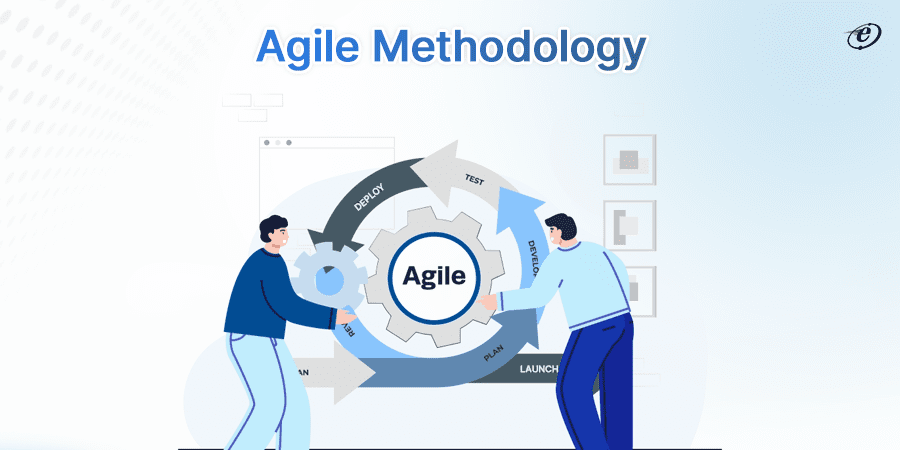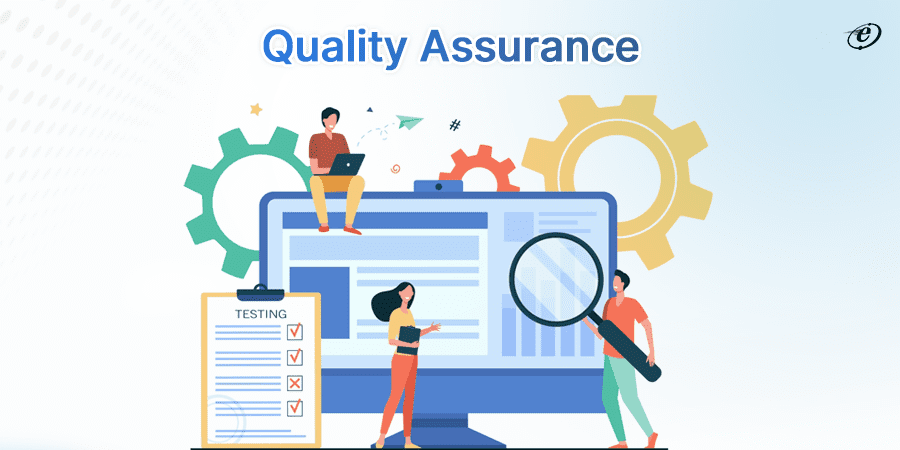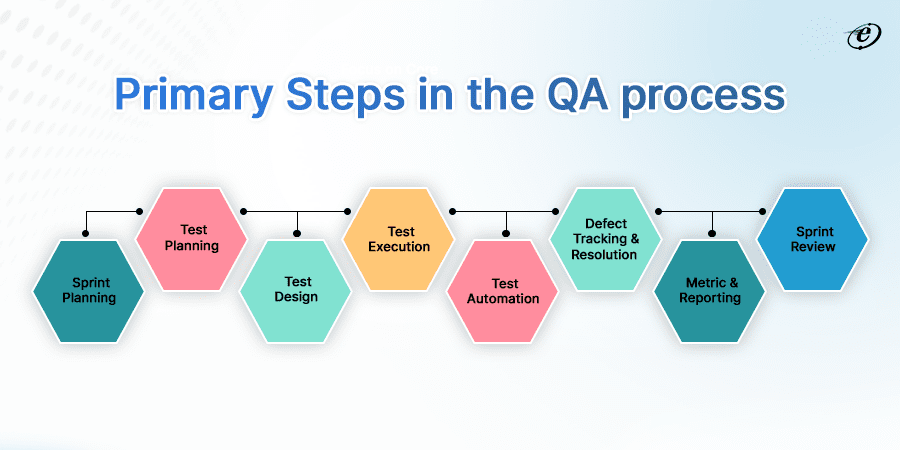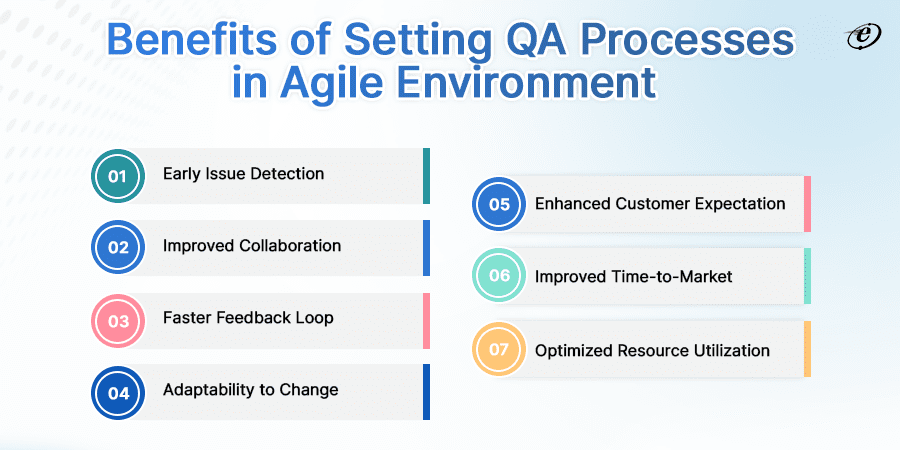
A Guide to QA Process in Agile: Elevate Software Quality
In software development, quality is not merely a procedure; it is an organizational culture penetrating every facet of the business. It entails a common way of interacting with others and prioritizing excellence and client satisfaction.
This blog is for you if you’re a manager wanting to enhance your organization’s Agile process or a quality assurance specialist trying to broaden your skill set. We will dive in and learn about the QA process in the Agile world.
Today’s world is fundamentally dependent on software. More than a hundred digital solutions are offering comparable goods and services, indicating heightened rivalry do. Therefore, there is an increased risk of losing customers anytime, and software updates or early feedback are not working.
Global business organizations are facing a shared trend of rising customer demands, technological advancements, and instability in their working environments.
Most businesses are being forced to adopt or use “Agile,” a flexible and progressive software development process or model. Agile techniques have become increasingly popular because they produce high-quality results quickly.
According to Statista 2018 report, 91 percent of participants said their company used an agile development process, and 88 percent said they used continuous integration. Leading software development companies claim that enterprises with robust QA processes in Agile methodology encounter 25% fewer issues with production.
Agile strongly emphasizes teamwork, flexibility, and ongoing development, which helps teams produce high-quality software more quickly and effectively.
Quality Assurance (QA) is a key component of the Agile process that guarantees the finished product meets or surpasses customer expectations.
We need to smoothly incorporate the QA process in Agile methodology in the realm of Agile. However, how does QA fit into the Agile process overall, and how does it interact with the other stages of the development cycle?
In this blog, we will examine the benefits, techniques, and guiding principles of the QA process in Agile methodology.
Let’s first understand Agile methodology and why it is necessary for your business.
What is Agile Methodology?

The agile technique is a flexible and iterative approach to web development, emphasizing collaboration, adaptability, and customer feedback.
This methodology breaks the project up into segments. Stakeholder communication and project development must be ongoing during these phases. When the project begins, the QA team goes through a planning, development, evaluation, and production phase.
Agile promotes a customer-centric focus, with regular client involvement throughout the development process. Teams collaborate closely, responding swiftly to changing requirements and incrementally delivering functional, high-quality software.
The dedicated software development teams have replaced waterfall techniques with agile project development processes. Scrum and Kanban are two agile approaches that have gained widespread traction among big and small enterprises.
Here are some solid reasons to choose Agile Methodology for your next project
-
- Agile adapts to changing project requirements, enhancing responsiveness.
- Regular client involvement ensures alignment with user needs and expectations.
- Continuous assessment and adjustments foster rapid problem-solving.
- Encourages close, cross-functional collaboration for efficient and effective outcomes.
- Prioritizes features based on customer value, optimizing resource utilization.
- Open communication and visibility into progress enhance stakeholder understanding.
- Embraces changes and adjusts plans to optimize project outcomes.
- Continuous testing and integration contribute to the delivery of robust, high-quality products.
What is Quality Assurance (QA) in Software Development?

Quality Assurance (QA) is a systematic process for ensuring software meets specified requirements and standards. It involves planning, designing, and executing tests to identify and rectify defects before software deployment.
Imagine building a toy car. In the QA process, you’d start by planning how the vehicle should look and work, similar to defining requirements for software. Then, you’d create a checklist of things to test—wheels turning, paint quality, etc. This systematic checking and fixing represents the QA process, ensuring the toy (or software) meets standards and works well before reaching the hands of users.

The QA analyst encompasses activities like test planning, test case creation, execution, and regression testing. Continuous feedback and collaboration with development teams are integral, promoting a proactive approach to identifying and addressing issues.
The QA process aims to enhance software quality, functionality, and user satisfaction through rigorous testing methodologies, ensuring a reliable and high-performing final product.
Now let’s understand why we should merge QA process in Agile techniques.
Want to connect with QA experts that are ISTQB-certified? Know more about our team to get in-depth details.
Understand the Role of QA Process in Agile

The 15th State of Agile Report stated that improving the capacity to handle shifting priorities and speeding up product delivery are the two most essential justifications for implementing Agile.
Additionally, studies reveal that developers manage technical debt for an average of one day per week, which lowers team morale and impedes progress.
Although the entire organization is impacted by technical debt, engineers are particularly more affected since higher levels of debt lead to more bugs, performance problems, downtime, sluggish delivery, unpredictable sprints, and, therefore, less time for working on exciting new projects.
Agile software testing and development must include quality assurance (QA) since it guarantees that the final product satisfies client requirements and meets all relevant quality standards.
If we implement the QA process in Agile, it identifies and addresses technical debt early in development cycles. Continuous testing and collaboration ensure prompt detection of code issues, allowing teams to resolve them proactively. This prevents the accumulation of technical debt, enhancing software quality and maintainability throughout the Agile development lifecycle.
A proficient QA team would be better able to address outstanding issues and promptly provide feedback. This makes it possible for developers to make adjustments and travel back and forth efficiently during the application development process. It even aids in reducing time, expenses, and effort. Ultimately, it promotes cost-effectiveness and quicker response times, both of which are essential in this digital transformation era.
Find top 10 digital tranformation agencies in 2025.
Let’s discover the different steps involved in QA process in agile methodology.
Find the Different Steps in the QA process in Agile Methodology
The iterative and collaborative nature of Agile development is reflected in the multiple stages of the Agile QA process. These stages contribute to the overall goal of continuously delivering high-quality software. Here are the key stages:

1. Sprint Planning
The dedicated development team selects the user stories that will be covered in the next sprint during sprint planning. QA professionals actively participate in project discussions and planning sessions. They collaborate with product owners and developers to understand user stories, define acceptance criteria, and identify potential test scenarios. This early involvement ensures a shared understanding of quality expectations.
2. Test Planning
The development team and QA specialists work together to specify test cases, determine test data needs, and create a testing plan for the next sprint. This plan includes prioritizing critical test cases, defining testing environments, and identifying potential automation opportunities.
3. Test Design
QA teams develop test cases and checklists based on software requirements, including conditions, data, and actions, to evaluate functionality depending on user stories and acceptance criteria. After that, staging areas are set up to guarantee precise testing circumstances.
Learn about penetration testing methodologies.
4. Test Execution
Based on the specified test scenarios and acceptance criteria, QA engineers carry out functional, integration, and regression tests as development moves forward. Any flaws are quickly reported to the development team and documented.
Looking for an agile team that can solve your bug woes? End your search by connecting with our quality testing team.
5. Test Automation
Agile embraced continuous testing throughout the development cycle. QA specialists can concentrate on more exploratory and creative testing by using automated tests to complete monotonous and time-consuming chores.
6. Defect Tracking & Resolution
Throughout the QA process in Agile, defects and issues are tracked using a collaborative tool. QA teams work closely with developers to address identified issues promptly. This collaboration ensures a smooth resolution process, reducing the likelihood of defects carrying over to subsequent iterations.
7. Metric & Reporting
Now the QA team gathers and examines metrics on test execution, defect density, and test coverage. With this data, web development teams may make well-informed decisions to continuously improve procedures and gain insights into the program’s overall quality.
8. Sprint Review
At the end of each sprint, development teams conduct a sprint review and retrospective. QA professionals actively participate, providing insights into the quality of the delivered product and suggesting improvements for the next sprint.
As we have seen, the QA process in Agile is integrated throughout the entire development lifecycle, emphasizing collaboration, continuous testing, and adaptability to change. With this iterative approach, leading website or web app development companies ensure that software is consistently delivered with high quality, meeting user expectations and business objectives.
QA Process in Agile: Best Practices Followed by Experts
Using agile approaches in your development process is essential to producing a highly functional and effective final product. The enterprises must include the following best practices to maximize the quality assurance process in Agile methodologies:

-
Estimate User Stories
When estimating user stories, consider the requirements for testing efforts. Initiate early user story engagement, focusing on necessary agile testing, planning, and design to accelerate these stories’ completion and acceptance.
-
Risk Analysis
The process of identifying and evaluating risks and their implications is known as risk analysis. It aids teams in avoiding and reducing dangers. Any Agile QA process must include risk analysis, which entails locating and assessing potential hazards and their effects.
A dedicated quality assurance team should reduce or eliminate essential errors by comprehending all possible project outcomes and implementing preventative measures.
-
Collaborative Planning
Agile techniques, like Scrum, place a strong emphasis on teamwork. Through this cooperation, any misunderstandings regarding requirements between the teams are reduced.
Collaborate on test planning with cross-functional teams. Shared planning sessions improve alignment between development and QA teams, fostering collective responsibility for software quality.
Since collaboration is critical for any IT project, our team strives hard to offer seamless services for our clients. Know why clients choose us?
-
Automating When Possible
With automation, developers may change the system as the problem is identified quickly and resolved before going to the QA division. Automation is expensive to deploy, but over time, it saves money by boosting productivity between the QA and development teams.
Regression testing takes less time using automation, which increases QA team productivity. It is important to carefully prioritize and automate test cases because over-automation can result in false breakdowns. The development and quality assurance teams’ cooperation and long-term efficiency are enhanced by automation despite its early expenses.
-
Implement Shift Left Testing
Early testing finds and fixes problems closer to their source, which lowers the cost of addressing faults. An approach known as “shift-left testing” strongly emphasizes testing early in the development cycle. Top web development firms use this strategy to guarantee that quality is included from the start and contributes to creating a more stable and dependable product.
-
Continuous Improvement
Continuous improvement is a top priority for agile development approaches, and integrating a QA process into agile fits right in with this philosophy. QA specialists provide helpful insight to support initiatives for continuous improvement by sharing their experiences and thoughts. They can recommend ways to improve test coverage and efficiency, point out where test automation can be used, and improve the testing procedure.
-
Cross Functional Team
Cross-functional abilities are expected of all members of Agile teams, and QA is no different. Encourage cross-functional collaboration between QA, dedicated developers, and other stakeholders. This collaboration ensures a holistic approach to quality, with everyone contributing to the testing process and a shared understanding of user stories.
-
Continuous Learning & Adaptation
Continuous learning and adaptation in the QA process in Agile is crucial, as it fosters a culture of improvement. Web development teams stay abreast of emerging technologies, industry best practices, and project-specific insights. This adaptability ensures that QA processes remain effective, efficient, and aligned with evolving project requirements in a dynamic Agile environment.
A guide to building a web development team in 2023–24
-
Test Driven Development
Test-driven development (TDD) is vital in the QA process in Agile as it promotes a proactive approach to quality. Writing tests before code ensures that development aligns with requirements.
TDD leads to more robust, maintainable code, facilitates early defect detection, and provides a safety net for code changes. It contributes to the rapid identification and resolution of issues, fostering continuous improvement and ensuring high-quality software delivery in Agile projects.
Top Reasons to Implement QA Process in Agile Techniques
Implementing QA processes within Agile methodologies yields numerous benefits, ensuring the consistent delivery of high-quality software and fostering a culture of continuous improvement. Here are the key advantages:

-
Early Issue Detection
According to experienced web development companies, defects are found early if we implement the Agile QA processes. This reduces the time and money needed for later corrections.
-
Improved Collaboration
QA professionals actively collaborate with developers and other team members in Agile projects. This collaboration fosters a shared responsibility for quality, aligning the efforts of cross-functional teams toward common objectives.
-
Faster Feedback Loop
A quick feedback loop is necessary for quick iteration and course correction in agile development. The QA process’s ability to accelerate the feedback loop helps teams avoid the hazards of delayed input, which can result in increased expenses and time-consuming rework.
-
Adaptability to Change
QA processes in Agile methodology are designed to accommodate changes in requirements. QA professionals actively participate in grooming sessions, adjusting test cases to align with evolving user stories and promoting flexibility and adaptability.
-
Enhanced Customer Expectation
The ultimate effect on customer satisfaction is the biggest advantage of implementing a QA process in an Agile setting. Delivering value to clients is prioritized by agile approaches by design. Agile quality assurance ensures that the finished product meets client requirements, improving user experiences and increasing customer satisfaction.
-
Improved Time-to-Market
Continuous testing and early issue detection contribute to faster delivery cycles. QA processes in Agile methodology ensure that software is of high quality, allowing for quicker releases and reducing time-to-market.
-
Optimized Resource Utilization
Setting the QA process in Agile maximizes resource use by smoothly incorporating testing into development cycles. Automated testing solutions increase productivity and free up teams to work on more intricate areas of testing.
Connect with an agile team that implements relevant development methodologies in various segments.
Discover Agile Excellence with eLuminous’ QA Expertise
In software development, quality is not merely a procedure but an organizational culture penetrating every facet of the business. It entails a common way of thinking, acting, and prioritizing excellence and customer satisfaction.
QA processes improvement: Tips for effective optimizations
Implementing QA processes in Agile methodology ensures the delivery of software with high quality and promotes collaboration, adaptability, and continuous improvement. These benefits contribute to the overall success of Agile projects, meeting the evolving needs of users and stakeholders.
eLuminous robust team knows how important quality assurance is to the timely and effective delivery of high-caliber software solutions. Our deep knowledge of Agile approaches, coupled with our emphasis on teamwork, automation, and ongoing enhancement, placed us in an ideal position to assist you in achieving remarkable software quality without sacrificing development speed.
Learn more about our Agile QA processes.
Frequently Asked Questions
-
Waterfall vs Agile Methodology: which is best?
The choice between Waterfall and Agile depends on project requirements. Waterfall suits well-defined, stable projects, while Agile is adaptable for dynamic ones. Agile promotes iterative development, customer collaboration, and flexibility, making it often preferred for its responsiveness to changing needs. The best choice varies based on project characteristics and organizational preferences.
-
Why should I implement QA process in Agile techniques?
Implementing QA processes in Agile methodology ensures early defect detection, faster issue resolution, and continuous improvement. It promotes collaboration, adapts to changing requirements, and delivers high-quality software iteratively. Integrating QA in Agile methodologies enhances efficiency, reduces risks, and aligns with dynamic project needs for overall project success.
-
How do I find a proficient QA analyst for my project?
To find a proficient QA analyst:
Utilize professional networks like LinkedIn and specialized job platforms or engage with QA communities.
Look for candidates with relevant experience, a proactive approach to problem-solving, and strong communication skills.
Conduct thorough interviews, assess past projects, and consider certifications to ensure expertise and compatibility with your project.




